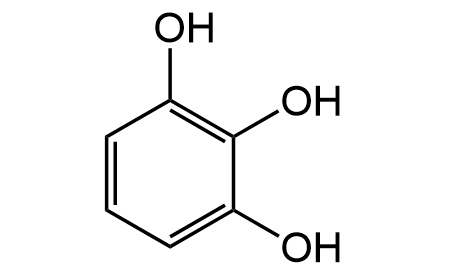Pyrogallol
| Code | Size | Price |
|---|
| CDX-Y0964-G100 | 100 g | £115.00 |
Quantity:
| CDX-Y0964-G500 | 500 g | £416.00 |
Quantity:
Prices exclude any Taxes / VAT
Overview
Regulatory Status: RUO
Shipping:
Ambient
Storage:
Short term: +20°C. Long term: +20°C
Images
Documents
Further Information
Alternate Names/Synonyms:
2-Hydroxyresorcinol; 1,2,3-Trihydroxybenzene; 2,3-Dihydroxyphenol; Pyrogallic acid
Appearance:
White to off-white powder.
CAS:
87-66-1
EClass:
32160000
Form (Short):
solid
GHS Symbol:
GHS07,GHS08
Handling Advice:
Protect from light and moisture.
Hazards:
H302 + H312 + H332 - H341 - H412
InChi:
InChI=1S/C6H6O3/c7-4-2-1-3-5(8)6(4)9/h1-3,7-9H
InChiKey:
WQGWDDDVZFFDIG-UHFFFAOYSA-N
Long Description:
Chemical. CAS: 87-66-1. Formula: C6H6O3. MW: 126.11. The Polyphenol pyrogallol is a powerful naturally occuring reducing agent. Due to its oxygen radical generating property, pyrogallol is commonly used as a photographic developing agent, in hair dying industry, as an antiseptic and to calculate the amount of oxygen in the air. Pyrogallol is a potent superoxide anion (O2?-) generator. Pyrogallol causes oxidative damage and induces mutagenesis, carcinogenesis and hepatotoxicity. It impairs immune responses, inhibits phagocytosis and suppresses the proliferation due to its strong free radical generating potential. As a superoxide generator it is commonly used to investigate the role of free radicals in the biological system. It is a potent inducer of Nrf2-mediated gene expression. Pyrogallol possesses anti-bacterial, anti-fungal, anti-psoriatic anti-cancer, anti-inflammatory and neuroprotective properties. Pyrogallol induces apoptosis in lung cancer cells via the overproduction of O2?- and affects mitogen activated protein kinases (MAPKs). Pyrogallol exerts antitumor effects via S-phase arrest and inhibition of PI3K/AKT/Skp2/cMyc signaling. Pyrogallol is a neuroprotective compound shown to work as dual modulators for the treatment of AD by inhibiting aggregation or promoting dissociation of Abeta and tau. Pyrogallol is an anti-biofilm agent. It reduces biofilm formation in S. aureus and S. epidermidis in a mechanism involving induction of bacterial oxidative stress. Pyrogallol can be used as an organic building block or intermediate for synthesis of different types of sensors (for colorimettic detection) or other biological active compounds (e.g. antivirals). It is also used as a metal-complexing agent.
MDL:
MFCD00002192
Molecular Formula:
C6H6O3
Molecular Weight:
126.11
Package Type:
Vial
Precautions:
P273 - P280 - P301 + P312 - P302 + P352 + P312 - P304 + P340 + P312 - P308 + P313
Product Description:
The Polyphenol pyrogallol is a powerful naturally occuring reducing agent. Due to its oxygen radical generating property, pyrogallol is commonly used as a photographic developing agent, in hair dying industry, as an antiseptic and to calculate the amount of oxygen in the air. Pyrogallol is a potent superoxide anion (O2?-) generator. Pyrogallol causes oxidative damage and induces mutagenesis, carcinogenesis and hepatotoxicity. It impairs immune responses, inhibits phagocytosis and suppresses the proliferation due to its strong free radical generating potential. As a superoxide generator it is commonly used to investigate the role of free radicals in the biological system. It is a potent inducer of Nrf2-mediated gene expression. Pyrogallol possesses anti-bacterial, anti-fungal, anti-psoriatic anti-cancer, anti-inflammatory and neuroprotective properties. Pyrogallol induces apoptosis in lung cancer cells via the overproduction of O2?- and affects mitogen activated protein kinases (MAPKs). Pyrogallol exerts antitumor effects via S-phase arrest and inhibition of PI3K/AKT/Skp2/cMyc signaling. Pyrogallol is a neuroprotective compound shown to work as dual modulators for the treatment of AD by inhibiting aggregation or promoting dissociation of Abeta and tau. Pyrogallol is an anti-biofilm agent. It reduces biofilm formation in S. aureus and S. epidermidis in a mechanism involving induction of bacterial oxidative stress. Pyrogallol can be used as an organic building block or intermediate for synthesis of different types of sensors (for colorimettic detection) or other biological active compounds (e.g. antivirals). It is also used as a metal-complexing agent.
Purity:
>99% (GC)
Signal Word:
Warning
SMILES:
OC1=C(O)C=CC=C1O
Solubility Chemicals:
Soluble in ethanol (20mg/ml), water (20mg/ml) or DMSO (50mg/ml).
Source / Host:
Synthetic
Transportation:
Non-hazardous
UNSPSC Number:
12352200
Use & Stability:
Stable for at least 2 years after receipt when stored at RT.
References
(1) E. Nicolis, et al.; Int. Immunopharmacol. 8, 1672 (2008) | (2) N. Ni, et al.; Bioorg. Med. Chem. Lett. 18, 1567 (2008) | (3) Y.H. Han, et al.; Toxicol. In Vitro 22, 1605 (2008) | (4) Y.H. Han, et al.; Chem. Biol. Interact. 177, 107 (2009) | (5) G. Upadhyay, et al.; Chem. Biol. Interact. 183, 333 (2010) (Review) | (6) M.S. Baliga & J.J. Dsouza; Eur. J. Cancer Prev. 20, 225 (2011) (Review) | (7) W.H. Park; Int. J. Oncol. 49, 785 (2016) | (8) M. Abderrahim, et al.; Talant 166, 349 (2017) | (9) K. Inoue, et al.; Luminescence 33, 277 (2018) | (10) H. Ahn, et al.; Int. J. Mol. Sci. 20, 3985 (2019) | (11) A. Anantram & M. Degani; Fut. Med. Chem. 11, 2287 (2019) (Review) | (12) H. Su, et al.; Nat. Commun. 12, 3623 (2021) | (13) V. Dangi, et al.; Methods 220, 79 (2023) | (14) S. Kim, et al.; Biomed. Pharmacother. 168, 115770 (2023) | (15) K.H.C. Roese, et al.; J. Appl. Microbiol. (Epub ahead of print) (2023)



